Investigating Enhanced Convection Heat Transfer in 3D Micro-Ribbed Tubes Using Inverse Problem Techniques
Abstract
1. Introduction
2. Problem Description
2.1. Physical Model
2.2. Governing Equations and Boundary Conditions
- Velocity inlet:
- Pressure outlet:
- Constant temperature surface of tube and micro-rib:
- Extension section wall:
2.3. Parameter Definitions
2.4. Grid Independence Test
2.5. Model Validation
3. Inverse Problem
3.1. Discrete Adjoint Optimization Method
3.2. Adjoint Equation Solving
3.3. Design Variables Optimization Process
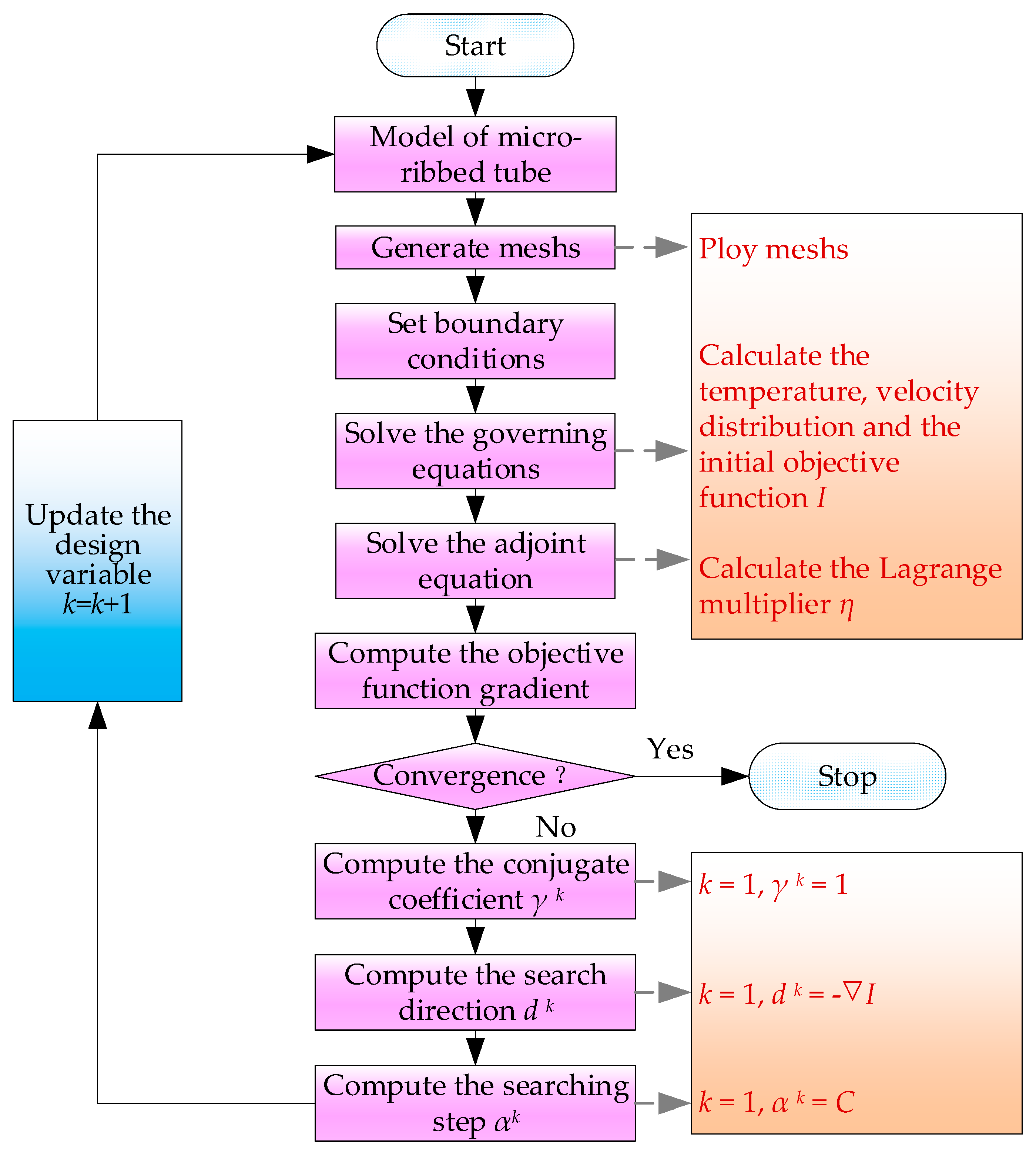
4. Results and Discussions
4.1. Effect of Micro-Rib Structures on the Thermo-Hydraulic Performance
4.2. Coupling Optimization of the Rib Relative Roughness Height (e/D)
4.3. Analysis of Entransy Dissipation Value of the Optimized Tube
4.4. Comparisons with Other Studies
5. Conclusions
- (1)
- The relationship between the micro-rib structural parameters and the thermo-hydraulic performance of the tube is highly interconnected. Specifically, the method of arrangement (D-type and U-type) dictates the optimal location for heat transfer effectiveness, with an increase in the number of circumferential rows (N) leading to improved fluid mixing near the tube wall and center. The inclined angle (β) can create a longitudinal vortex to enhance heat transfer, while the height (e) of the micro-rib is a critical structural parameter influencing flow and heat transfer within the tube.
- (2)
- The discrete adjoint method offers a numerical solution that is advantageous for optimizing the coupling of multiple parameters in micro-ribbed tubes. By prioritizing the PEC as the objective function, it allows for the creation of a unique structure with varying rib heights. Interestingly, varying initial values can result in similar objective function values. The optimized ribbed tube shows a significant 64.9% improvement in PEC compared to a smooth tube. The range between the minimum and maximum e/Di (i = 1–19) is approximately 5.7%.
- (3)
- The optimized micro-ribbed design sacrifices some heat transfer performance; however, the optimized tube exhibits a higher PEC value compared to previous studies at Reynolds numbers greater than 10,000. More specifically, the PEC is 10.65% to 22.78% greater than that of the existing structure within the same range.
- (4)
- Finally, it is noteworthy that the concept of multi-parameter coupling optimization presented in this paper can be extended to other inverse convective heat transfer problems governed by analogous governing equations. For instance, the design of multiple pin-fin heat exchanger flow channels can be optimized by selecting heat transfer performance and flow pressure drop as objective functions. This approach can facilitate the cooling of localized high-temperature hotspots or enhance the overall heat transfer rate, thereby contributing to the design of compact heat exchangers, electronic device cooling systems, and other related applications.
Author Contributions
Funding
Data Availability Statement
Conflicts of Interest
Abbreviations
| Nomenclature | Abbreviation | ||
| Cp,v | specific heat, J kg−1 K−1 | DAM | Discrete Adjoint Method |
| d | search direction | D-type | Common–Flow–Down type |
| D | tube diameter, mm | ETD | Equivalent Temperature Difference |
| Dh | hydraulic diameter, mm | FVM | Finite Volume Method |
| e | rib height, mm | IHTP | Inverse Heat Transfer Problem |
| Eh | entransy | PEC | Performance Evaluation Criteria |
| f | friction factor | TKE | Turbulent Kinetic Energy |
| h | convection heat transfer coefficient, W m−2 K−1 | U-type | Common–Flow–Up type |
| I | turbulence intensity; objective function | Greek symbols | |
| l | length of the extension, mm | α | search step size |
| L | length of the heating section, mm | β | inclined angle, ° |
| M | mass flow, kg/s | γ | conjugate coefficient |
| N | circumferential rows | ε | minimum value |
| Nu | Nusselt number | λ | thermal conductivity, W m−1·K−1 |
| p | spacing of ribs, mm | μ | fluid viscosity, Pa·s |
| Pr | Prandtl number | ρ | air density, kg m−3 |
| q | average heat flux, W m−2 | η | adjoint factor |
| Q | heat transfer rate, W | Subscripts | |
| r | circular-arc radius, mm | 0 | smooth tube |
| Re | Reynolds number | f | fluid area |
| sm | design variable | i | optimal value |
| T | temperature, K | in | inlet |
| Δtm | average temperature difference | init | initial |
| u, v, ω | velocity components, m s−1 | k | iteration steps |
| w | rib width, mm | opt | optimal value |
| out | outlet | ||
| w | tube wall |
References
- Cheng, J.; Qian, Z.; Wang, Q. Analysis of heat transfer and flow resistance of twisted oval tube in low Reynolds number flow. Int. J. Heat Mass Transf. 2017, 109, 761–777. [Google Scholar] [CrossRef]
- Liu, P.; Zheng, N.; Shan, F.; Liu, Z.; Liu, W. An experimental and numerical study on the laminar heat transfer and flow characteristics of a circular tube fitted with multiple conical strips inserts. Int. J. Heat Mass Transf. 2018, 117, 691–709. [Google Scholar] [CrossRef]
- Huang, S.; Deng, M.; Chen, Z.; Yang, D.; Xu, Y.; Lan, N. Experimental and numerical investigations on thermal-hydraulic performance of three-dimensional overall jagged internal finned tubes. Micromachines 2024, 15, 513. [Google Scholar] [CrossRef] [PubMed]
- Xu, K.; Sun, X.; Meng, H. Conjugate heat transfer, endothermic fuel pyrolysis and surface coking of aviation kerosene in ribbed tube at supercritical pressure. Int. J. Therm. Sci. 2018, 132, 209–218. [Google Scholar] [CrossRef]
- Cao, Y.; Ayed, H.; Anqi, A.E.; Tutunchian, O.; Dizaji, H.S.; Pourhedayat, S. Helical tube-in-tube heat exchanger with corrugated inner tube and corrugated outer tube; experimental and numerical study. Int. J. Therm. Sci. 2021, 170, 107139. [Google Scholar] [CrossRef]
- Xu, W.; Wang, S.; Liu, G.; Zhang, Q.; Lu, H. Experimental and numerical investigation on heat transfer of therminol heat transfer fluid in an internally four-head ribbed tube. Int. J. Therm. Sci. 2017, 116, 32–44. [Google Scholar] [CrossRef]
- Córcoles, J.I.; Belmonte, J.F.; Molina, A.E.; Almendros-Ibáñez, J.A. Influence of corrugation shape on heat transfer performance in corrugated tubes using numerical simulations. Int. J. Therm. Sci. 2019, 137, 262–275. [Google Scholar] [CrossRef]
- Li, M.; Khan, T.S.; Al-Hajri, E.; Ayub, Z.H. Single phase heat transfer and pressure drop analysis of a dimpled enhanced tube. Appl. Therm. Eng. 2016, 101, 38–46. [Google Scholar] [CrossRef]
- Góngora-Gallardo, G.; Castro-Gil, M.; Colmenar-Santos, A.; Tawfik, M. Efficiency factors of solar collectors of parallel plates for water. Sol. Energy 2013, 94, 335–343. [Google Scholar] [CrossRef]
- Okafor, I.F.; Dirker, J.; Meyer, J.P. Influence of non-uniform heat flux distributions on the secondary flow, convective heat transfer and friction factors for a parabolic trough solar collector type absorber tube. Renew. Energy 2017, 108, 287–302. [Google Scholar] [CrossRef]
- Gholami, A.; Wahid, M.A.; Mohammed, H.A. Thermal–hydraulic performance of fin-and-oval tube compact heat exchangers with innovative design of corrugated fin patterns. Int. J. Heat Mass Transf. 2017, 106, 573–592. [Google Scholar] [CrossRef]
- Raj, R.; Lakshman, N.S.; Mukkamala, Y. Single phase flow heat transfer and pressure drop measurements in doubly enhanced tubes. Int. J. Therm. Sci. 2015, 88, 215–227. [Google Scholar] [CrossRef]
- Hosseini, A.M.; Faghih Khorasani, A. Experimental and numerical study of the rib effect in a gas-gas heat exchanger performance used in a sponge iron production plant (MIDREX). Proc. Inst. Mech. Eng. A J. Pow. 2021, 235, 1747–1758. [Google Scholar] [CrossRef]
- Jia, B. Numerical Research on Integrated Heat Transfer Performance of the New Inner-Ribs Tubes. Master’s Thesis, Zhengzhou University, Zhengzhou, China, 2015. [Google Scholar]
- Liu, B.; Shi, C.; Liu, W.; Liu, Z. Research on heat exchange and flow resistance performance and multi-objective structural optimization of oval twist tube with two fins. J. Northeast Elec. Pow. Nniver. 2022, 42, 37–45. [Google Scholar] [CrossRef]
- Zheng, N.; Liu, P.; Shan, F.; Liu, Z.; Liu, W. Heat transfer enhancement in a novel internally grooved tube by generating longitudinal swirl flows with multi-vortexes. Appl. Therm. Eng. 2016, 95, 421–432. [Google Scholar] [CrossRef]
- Zheng, N.; Liu, P.; Shan, F.; Liu, Z.; Liu, W. Effects of rib arrangements on the flow pattern and heat transfer in an internally ribbed heat exchanger tube. Int. J. Therm. Sci. 2016, 101, 93–105. [Google Scholar] [CrossRef]
- Liu, P.; Lv, J.; Shan, F.; Liu, Z.; Liu, W. Effects of rib arrangements on the performance of a parabolic trough receiver with ribbed absorber tube. Appl. Therm. Eng. 2019, 156, 1–13. [Google Scholar] [CrossRef]
- Jin, G.; Bao, Y.; Guo, S.; Wu, X. Numerical simulation of the intensified heat exchange of cylindrical inner ribs and analysis of the entransy dissipation. J. Eng. Therm. Energy Pow. 2018, 33, 8–14. [Google Scholar] [CrossRef]
- Hong, Y.; Du, J.; Wang, S.; Huang, S. Heat transfer and flow behaviors of a wavy corrugated tube. Appl. Therm. Eng. 2017, 126, 151–166. [Google Scholar] [CrossRef]
- Du, J.; Hong, Y.; Huang, S.M.; Ye, W.B.; Wang, S. Laminar thermal and fluid flow characteristics in tubes with sinusoidal ribs. Int. J. Heat Mass Transf. 2018, 120, 635–651. [Google Scholar] [CrossRef]
- Wang, X.D.; Huang, Y.X.; Cheng, C.H.; Jang, J.Y.; Lee, D.J.; Yan, W.M.; Su, A. Flow field optimization for proton exchange membrane fuel cells with varying channel heights and widths. Electrochim. Acta 2009, 54, 5522–5530. [Google Scholar] [CrossRef]
- Leng, C.; Wang, X.D.; Wang, T.H.; Yan, W.M. Optimization of thermal resistance and bottom wall temperature uniformity for double-layered microchannel heat sink. Energy Convers. Manag. 2015, 93, 141–150. [Google Scholar] [CrossRef]
- Lin, L.; Chen, Y.Y.; Zhang, X.X.; Wang, X.D. Optimization of geometry and flow rate distribution for double-layer microchannel heat sink. Int. J. Therm. Sci. 2014, 78, 158–168. [Google Scholar] [CrossRef]
- Min, T.; Chen, X.; Sun, Y.; Huang, Q. A numerical approach to solving an inverse heat conduction problem using the Levenberg-Marquardt algorithm. Math. Probl. Eng. 2014, 2014, 626037. [Google Scholar] [CrossRef]
- Cui, M.; Zhao, Y.; Xu, B.; Gao, X. A new approach for determining damping factors in Levenberg-Marquardt algorithm for solving an inverse heat conduction problem. Int. J. Heat Mass Transf. 2017, 107, 747–754. [Google Scholar] [CrossRef]
- Zhang, D.D.; Zhang, J.H.; Liu, D.; Zhao, F.Y.; Wang, H.Q.; Li, X.H. Inverse conjugate heat conduction and natural convection inside an enclosure with multiple unknown wall heating fluxes. Int. J. Heat Mass Transf. 2016, 96, 312–329. [Google Scholar] [CrossRef]
- Yang, X.; Hu, J.; Fan, Y.; Min, C.; Wang, K. Enhanced heat dissipation of ribbed channels based on the coupling optimization of multiple structural parameters. Appl. Therm. Eng. 2023, 235, 121362. [Google Scholar] [CrossRef]
- Seo, J.W.; Afzal, A.; Kim, K.Y. Efficient multi-objective optimization of a boot-shaped rib in a cooling channel. Int. J. Therm. Sci. 2016, 106, 122–133. [Google Scholar] [CrossRef]
- Ansari, M.; Bazargan, M. Optimization of flat plate solar air heaters with ribbed surfaces. Appl. Therm. Eng. 2018, 136, 356–363. [Google Scholar] [CrossRef]
- Ponce-Ortega, J.M.; Serna-González, M.; Jiménez-Gutiérrez, A. Use of genetic algorithms for the optimal design of shell-and-tube heat exchangers. Appl. Therm. Eng. 2009, 29, 203–209. [Google Scholar] [CrossRef]
- Nabi, S.; Grover, P.; Caulfield, C.P. Adjoint-based optimization of displacement ventilation flow. Build. Environ. 2017, 124, 342–356. [Google Scholar] [CrossRef]
- Papoutsis-Kiachagias, E.M.; Giannakoglou, K.C. Continuous adjoint methods for turbulent flows, applied to shape and topology optimization: Industrial applications. Arch. Comput. Method Eng. 2014, 23, 255–299. [Google Scholar] [CrossRef]
- Menter, F.R. Two-equation eddy-viscosity turbulence models for engineering applications. AIAA J. 1994, 32, 1598–1605. [Google Scholar] [CrossRef]
- Guo, Z.Y.; Tao, W.Q.; Shah, R.K. The field synergy (coordination) principle and its applications in enhancing single phase convective heat transfer. Int. J. Heat Mass Transf. 2005, 48, 1797–1807. [Google Scholar] [CrossRef]
- He, Y.L.; Tao, W.Q. Numerical studies on the inherent interrelationship between field synergy principle and entransy dissipation extreme principle for enhancing convective heat transfer. Int. J. Heat Mass Transf. 2014, 74, 196–205. [Google Scholar] [CrossRef]
- Li, M.; Khan, T.S.; Hajri, E.A.; Ayub, Z.H. Geometric optimization for thermal–hydraulic performance of dimpled enhanced tubes for single phase flow. Appl. Therm. Eng. 2016, 103, 639–650. [Google Scholar] [CrossRef]
- Bilen, K.; Cetin, M.; Gul, H.; Balta, T. The investigation of groove geometry effect on heat transfer for internally grooved tubes. Appl. Therm. Eng. 2009, 29, 753–761. [Google Scholar] [CrossRef]
- Kathait, P.S.; Patil, A.K. Thermo-hydraulic performance of a heat exchanger tube with discrete corrugations. Appl. Therm. Eng. 2014, 66, 162–170. [Google Scholar] [CrossRef]

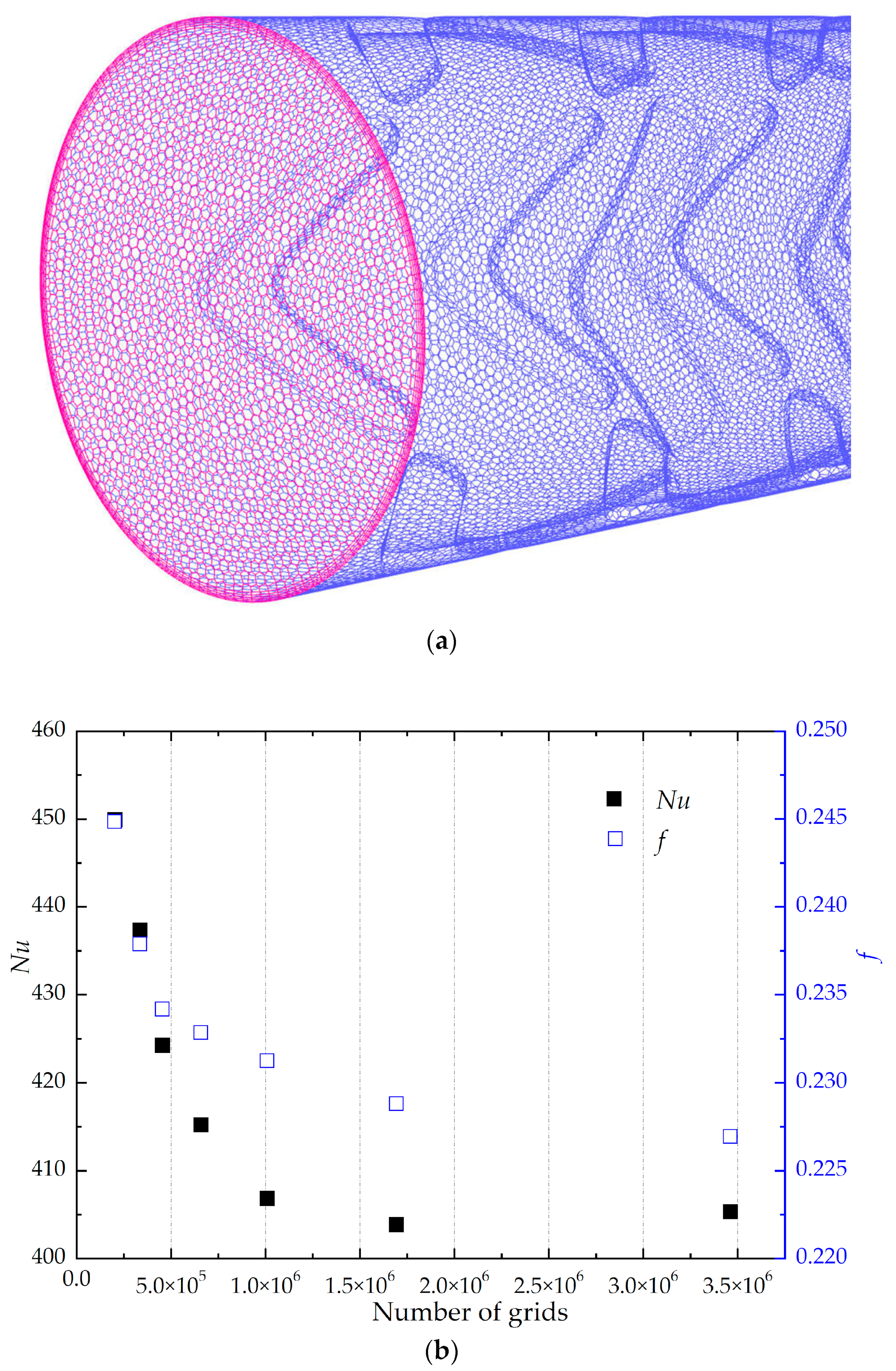

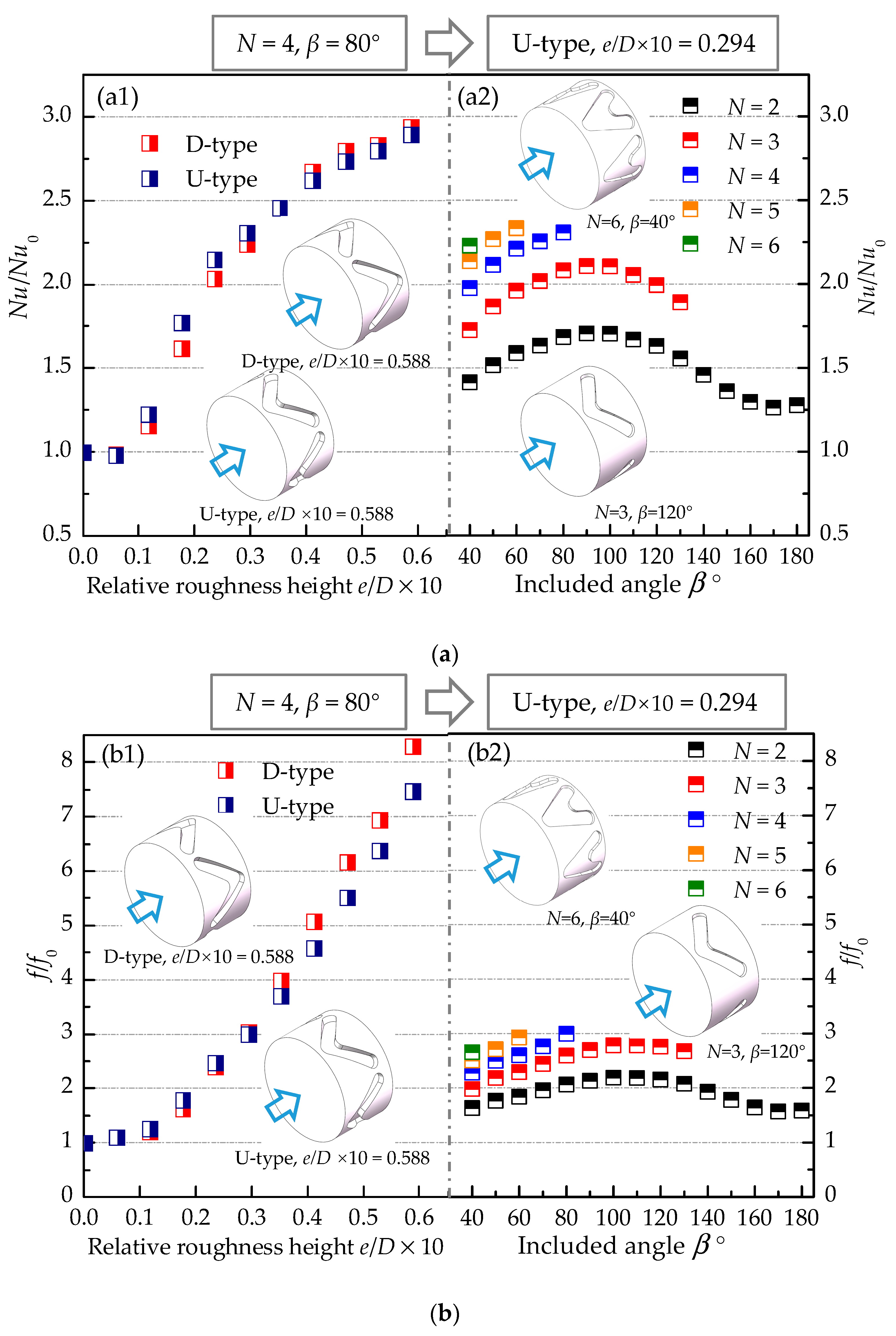
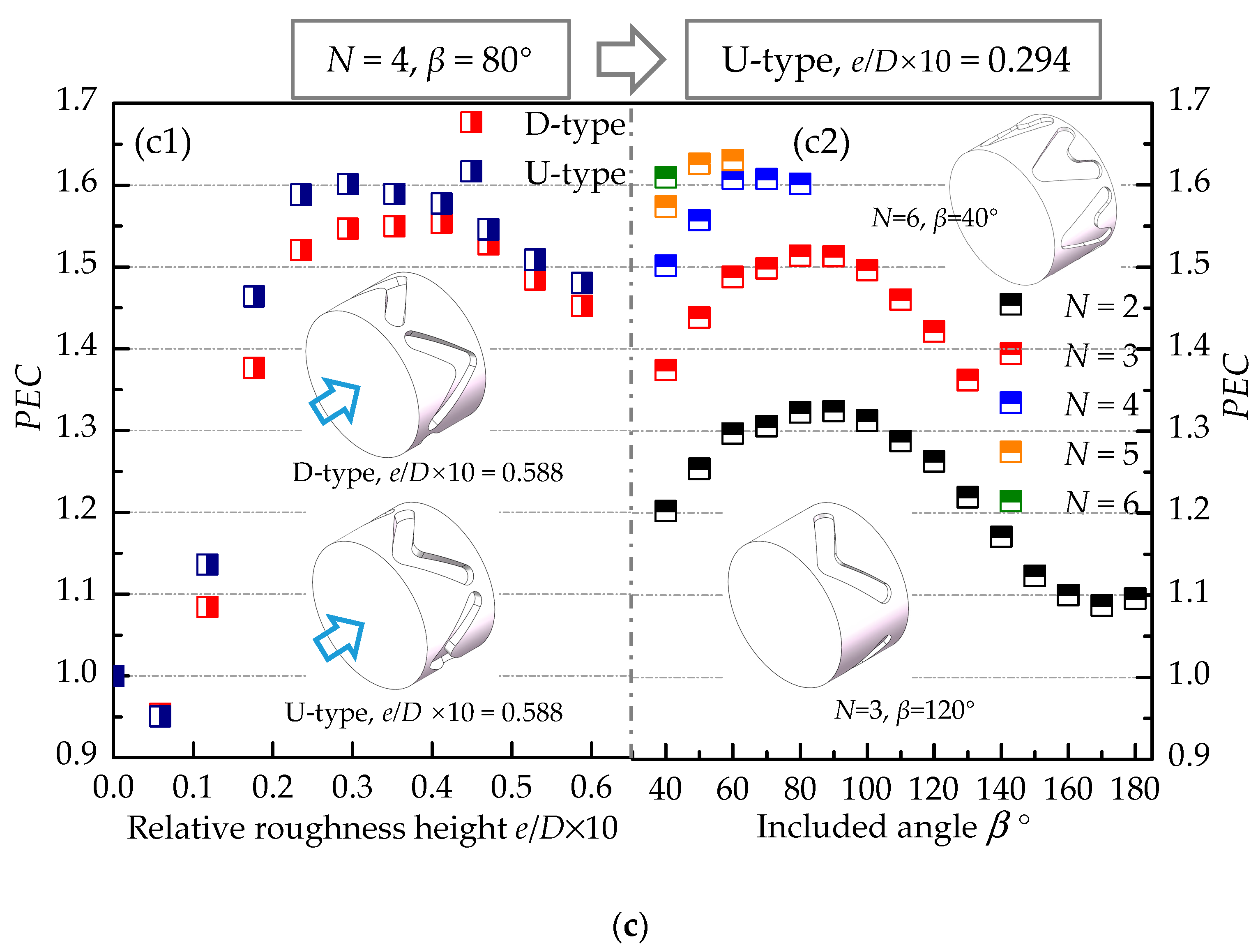
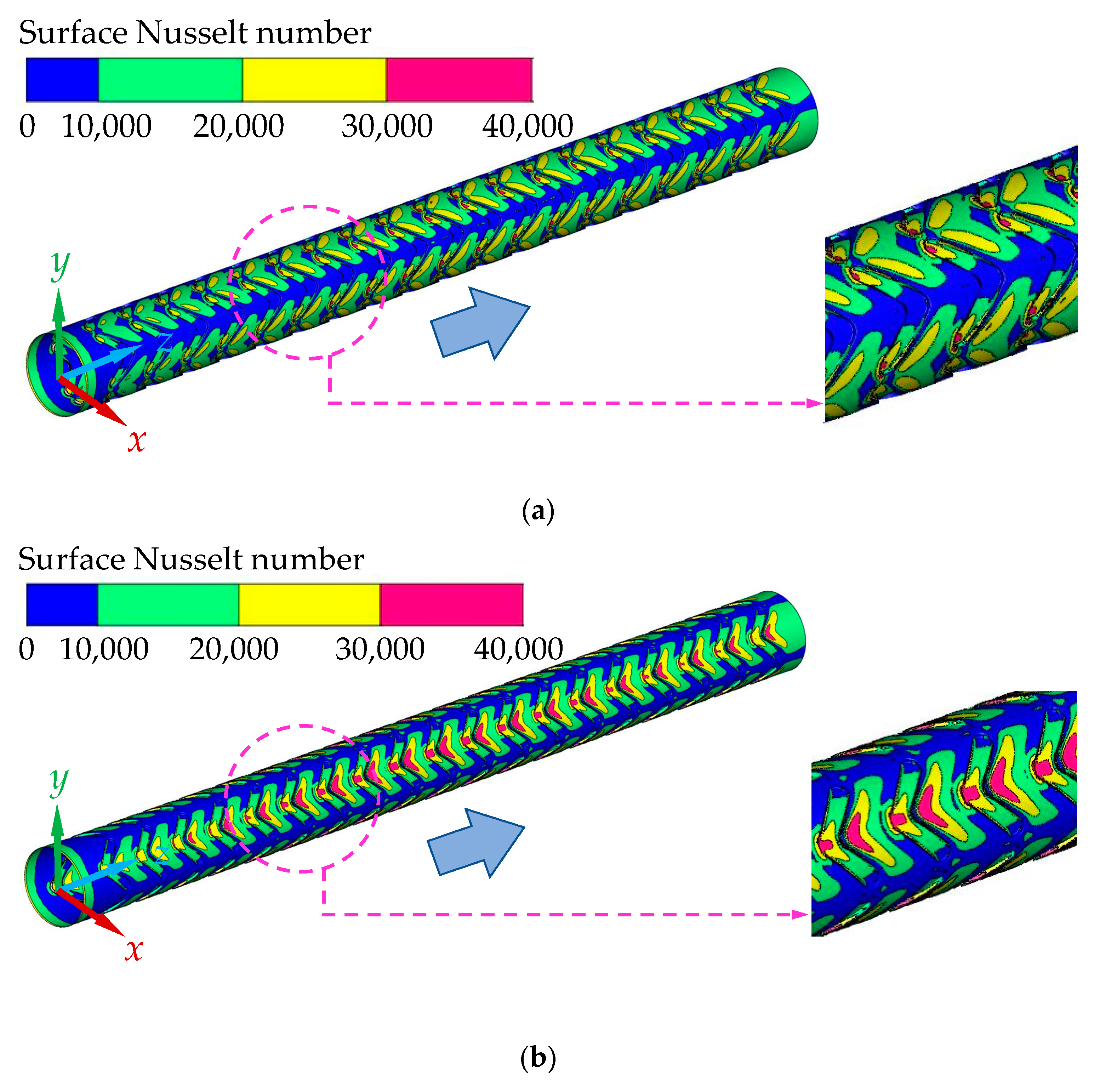
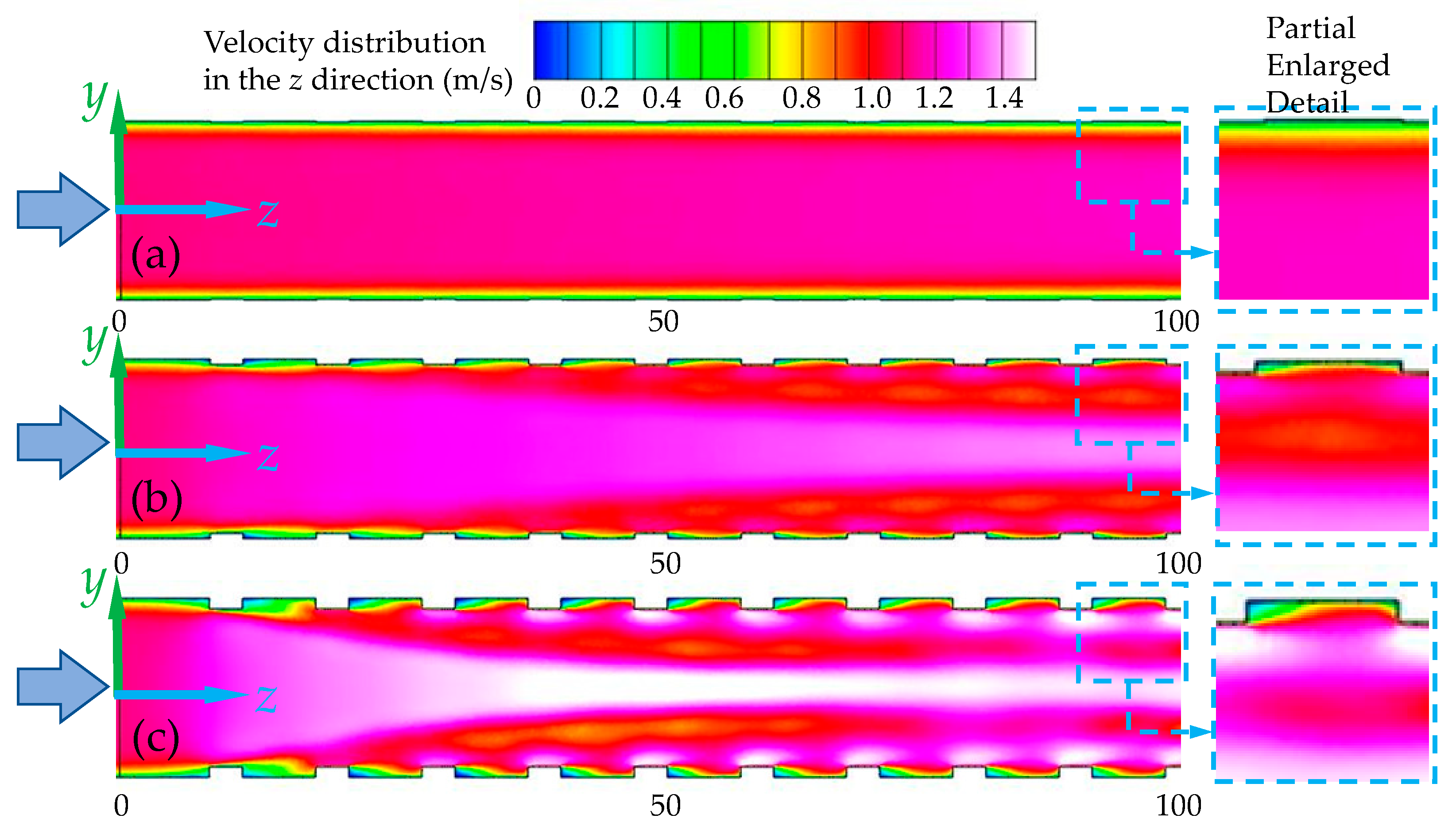
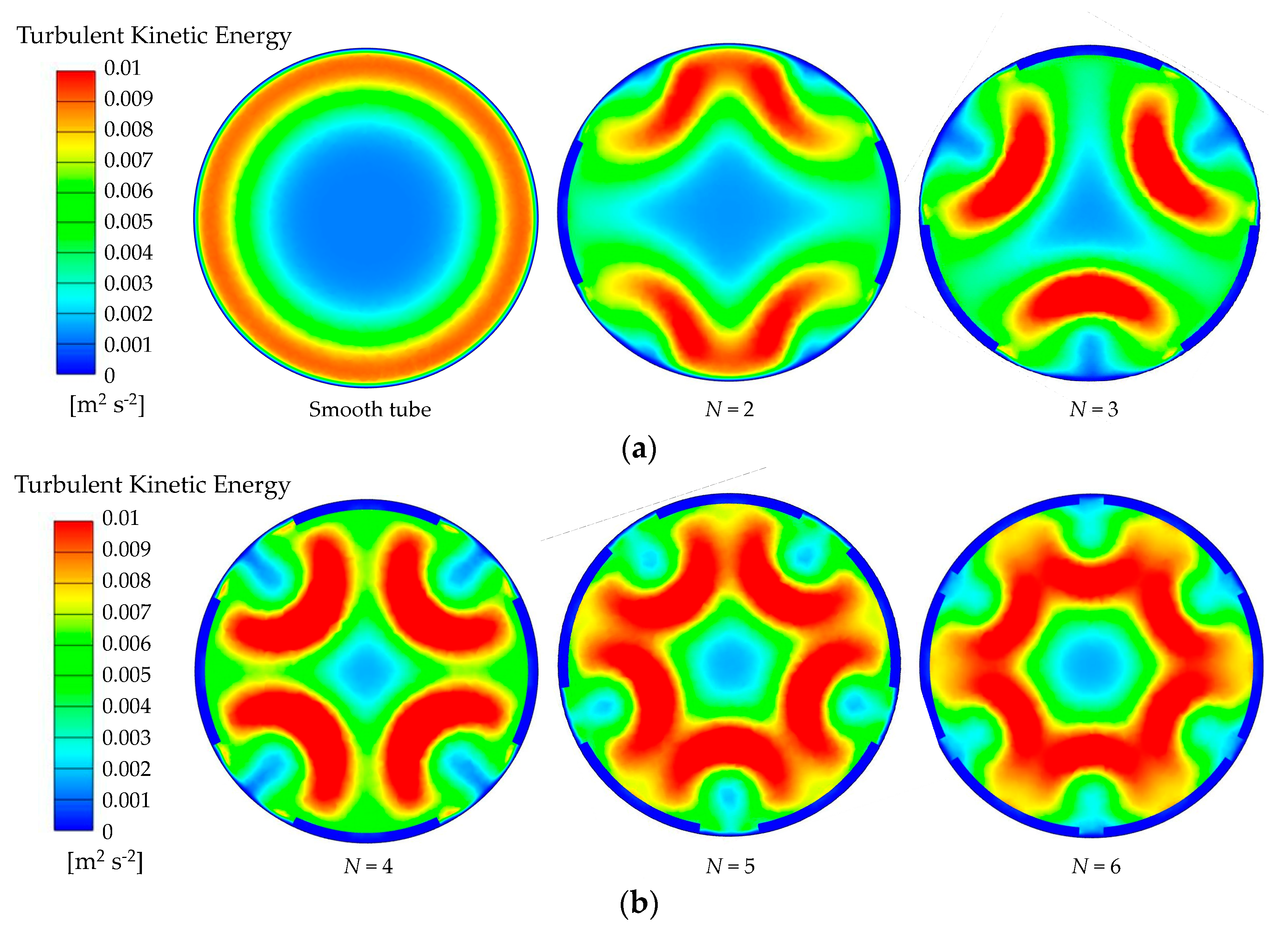

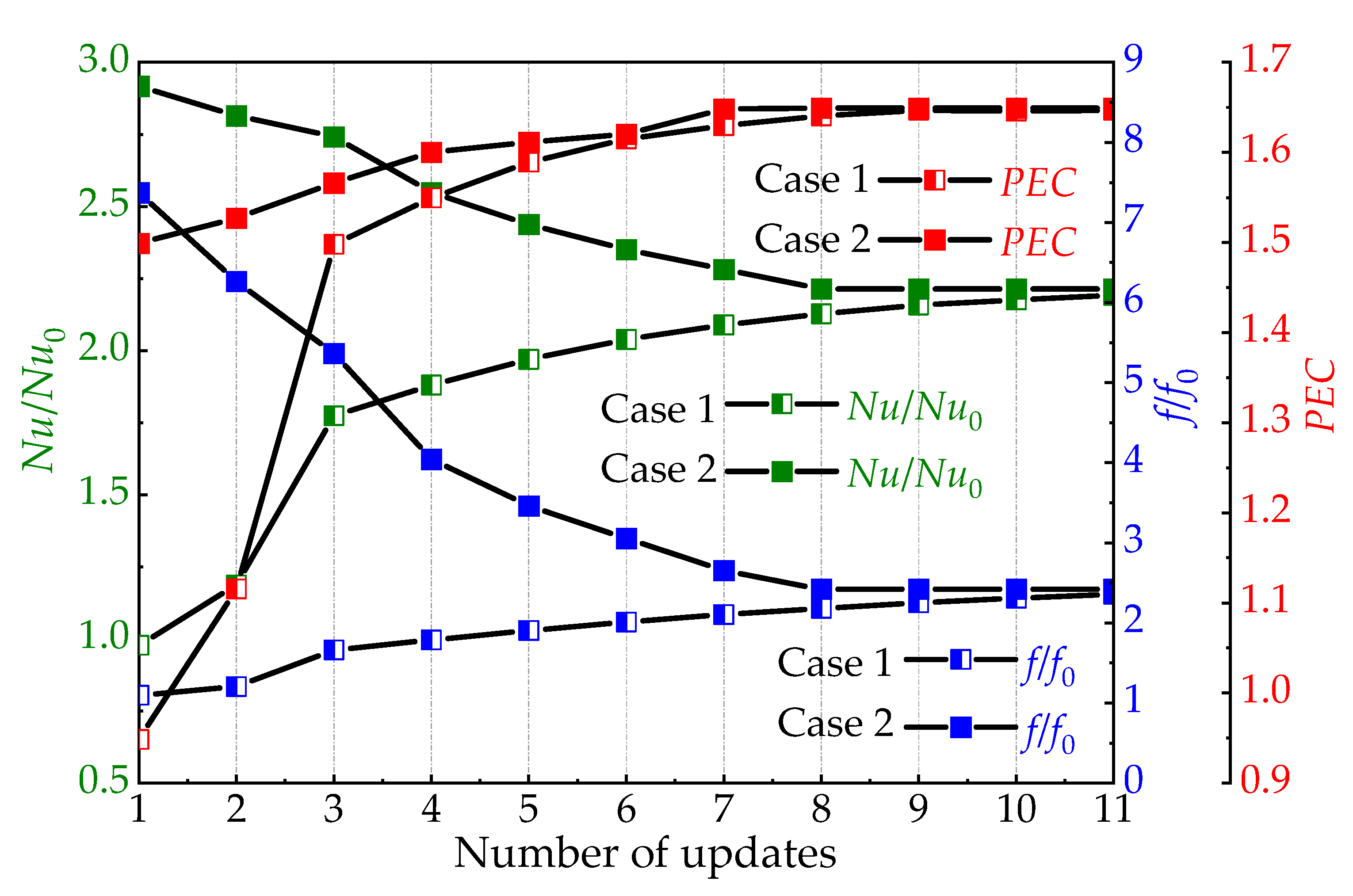

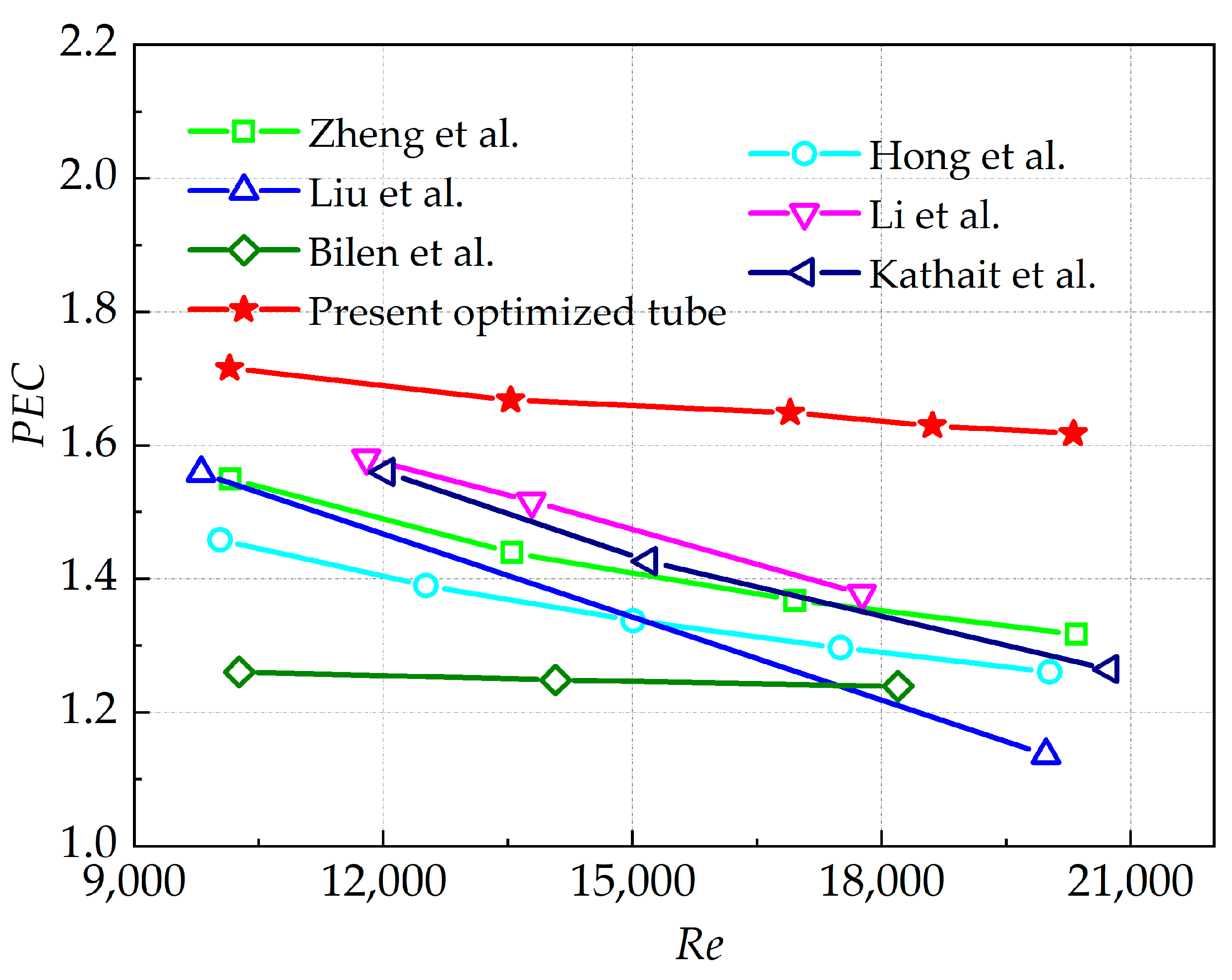
| Parameters | Symbol | Value |
|---|---|---|
| Rib length | I | 7 mm |
| Rib height | e | 0.1~1 mm |
| Rib width | w | 2 mm |
| Pitch | p | 10 mm |
| Radius of arc | r | 1 mm |
| Inclined angle | β | 60~180° |
| Circumferential rows | N | 2~6 |
| e/D1 | e/D2 | e/D3 | e/D4 | e/D5 | e/D6 | e/D7 | e/D8 | e/D9 | e/D10 |
| 0.02335 | 0.02327 | 0.02330 | 0.02337 | 0.02346 | 0.02358 | 0.02369 | 0.02380 | 0.02390 | 0.02399 |
| e/D11 | e/D12 | e/D13 | e/D14 | e/D15 | e/D16 | e/D17 | e/D18 | e/D19 | |
| 0.02404 | 0.02411 | 0.02417 | 0.02422 | 0.02431 | 0.02438 | 0.02444 | 0.02452 | 0.02459 |
Disclaimer/Publisher’s Note: The statements, opinions and data contained in all publications are solely those of the individual author(s) and contributor(s) and not of MDPI and/or the editor(s). MDPI and/or the editor(s) disclaim responsibility for any injury to people or property resulting from any ideas, methods, instructions or products referred to in the content. |
© 2024 by the authors. Licensee MDPI, Basel, Switzerland. This article is an open access article distributed under the terms and conditions of the Creative Commons Attribution (CC BY) license (https://creativecommons.org/licenses/by/4.0/).
Share and Cite
Wang, Z.; Yang, X.; Gu, X.; Su, Q.; Liu, Y.; He, X.; Li, Z. Investigating Enhanced Convection Heat Transfer in 3D Micro-Ribbed Tubes Using Inverse Problem Techniques. Energies 2024, 17, 5102. https://doi.org/10.3390/en17205102
Wang Z, Yang X, Gu X, Su Q, Liu Y, He X, Li Z. Investigating Enhanced Convection Heat Transfer in 3D Micro-Ribbed Tubes Using Inverse Problem Techniques. Energies. 2024; 17(20):5102. https://doi.org/10.3390/en17205102
Chicago/Turabian StyleWang, Zhihui, Xuguang Yang, Xiaohua Gu, Qingyong Su, Yan Liu, Xiujin He, and Zhiwei Li. 2024. "Investigating Enhanced Convection Heat Transfer in 3D Micro-Ribbed Tubes Using Inverse Problem Techniques" Energies 17, no. 20: 5102. https://doi.org/10.3390/en17205102
APA StyleWang, Z., Yang, X., Gu, X., Su, Q., Liu, Y., He, X., & Li, Z. (2024). Investigating Enhanced Convection Heat Transfer in 3D Micro-Ribbed Tubes Using Inverse Problem Techniques. Energies, 17(20), 5102. https://doi.org/10.3390/en17205102






